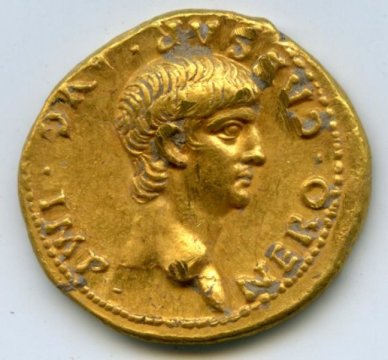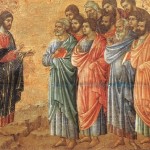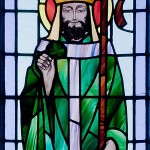
Archaeologists from the University of North Carolina at Charlotte are reporting that they’ve found a gold coin bearing the image of the mid-first century Roman emperor Nero, uncovered during excavations in the Western Hill of Jerusalem (more commonly referred to as Mount Zion).
This type of coin is in fact well-attested in the archaeological record. However, one of the lead professors associated with this find, Shimon Gibson, is quoted in the press release as saying
“The coin is exceptional,” said Gibson, “because this is the first time that a coin of this kind has turned up in Jerusalem in a scientific dig. Coins of this type are usually only found in private collections, where we don’t have clear evidence as to place of origin.”
The press release goes on to describe the coin:
The lettering around the edge of the coin reads: NERO CAESAR AVG IMP. On the reverse of the coin is a depiction of an oak wreath containing the letters “EX S C,” with the surrounding inscription “PONTIF MAX TR P III.”
“AVG” here is an abbreviation of Augustus, an honorary title that Nero adopted from his great-uncle, and one that would come to be used by virtually all Roman emperors after him—as would Imperator, a title with martial connotations (and the word that’s abbreviated “IMP” here).
“EX S C” stands for ex senatus consulto, “by decree of the Senate.” “PONTIF MAX TR P” is Pontifex Maximus, Tribunicia Potestate—the first part of this being the supreme Roman religious title (later adopted by Christian Popes), and then a title denoting the tribunician power; which when followed by the number “3” here (III) allows us to date the coin more precisely in Nero’s reign.
This all has significance for the study of early Christianity, as this can be connected with an important though enigmatic passage from the New Testament book of Revelation:
[The beast] causes all, both small and great, both rich and poor, both free and slave, to be marked on the right hand or the forehead, so that no one can buy or sell who does not have the mark, that is, the name of the beast or the number of its name. This calls for wisdom: let anyone with understanding calculate the number of the beast, for it is the number of a person. Its number is six hundred sixty-six (Revelation 13:16-18, NRSV)
There are several uncertain things about this, but Biblical scholars have now widely concluded that “person” that this number 666 refers to here is none other than the emperor Nero. This was originally discerned by way of gematria, an ancient Jewish method or practice that had to do with numerical values that were assigned to individual Hebrew letters (A = 1; B = 2, and so on)—in particular, calculating the combined value of these numbers in an individual word of phrase. (Refer to “let anyone with understanding calculate the number…”)
Although the book of Revelation was, of course, written in Greek, scholars have recognized that a Greek form of Nero’s name, Νέρων Καῖσαρ (Neron Caesar), when rendered into Hebrew/Aramaic¹ as נרון קסר, gives us a combined value of 666: 50 + 200 + 6 + 50 + 100 + 60 + 200.²
Several other considerations secure this identification. For example, some other early manuscript copies of the book of Revelation read not “666” but “616″; and when the Latin form of Nero’s name is rendered into Hebrew/Aramaic characters—נרו קסר—this yields a value in gematria value of precisely 616. (Also, interestingly, the word for “beast” in the passages of Revelation quoted above is θηρίον, thērion; and one very natural rendering of this word into Hebrew/Aramaic is תריון—which again has a gematriac value of exactly 666: 400 + 200 + 10 + 6 + 50.)
This newly discovered coin bears the Latin name in question here, NERO CAESAR. Further, although again there are several uncertainties regarding the passages in Revelation, the context is clearly a monetary/commercial one: “[the beast] causes all . . . to be marked on the right hand or the forehead . . . so that no one can buy or sell who does not have the mark, that is, the name of the beast…” In his recent commentary on Revelation, Craig Koester notes a few different options to explain what exactly this means, including that this refers specifically to
Using coins with the emperor’s picture. . . . For Jews opposed to Roman rule, coins bearing the emperor’s portrait could be considered a violation of the divine command not to make a graven image (Exod 20:4-6). The [New Testament] gospels say that when Jesus responded to question about taxes, he had his questioners produce a coin, which bore the emperor’s portrait. The coin showed their connection to the imperial system (Mark 12:13-17 par.). Revelation envisions the beast’s mark not only on the forehead, but on the right hand, perhaps because a person would hold a coin in the hand when making a sale (Caird; Murphy; Yarbro Collins, Crisis, 126-27; Kraybill, Imperial, 138-39; Taylor, “Monetary”). (Revelation: A New Translation with Introduction and Commentary, 596)
This might not be the final answer, but it certainly all sheds light on one of the most debated passages in Christian history: one that throughout history—and still today—has been and continues to be abused outside of its original context.
⁂ ⁂ ⁂
Notes
[1] A reader kindly reminds me that “a similar case of a Jewish author writing in Greek but using Hebrew numerology of Greek words” is found in the apocryphal Greek Apocalypse of Baruch (more commonly known as 3 Baruch). On this, Alexander Kulik notes that
Isopsephy-gematria techniques, although attested in general Hellenistic culture and abundant in Rabbinic sources, are presented in sole examples in Hellenistic Jewish literature (Syb [sic]. Or. 1:232–331; 5:12–51; Asc. Mos. 9:1; Rev 13:18; 21:17). 3 Baruch significantly supplements this list:
– 360, the number of rivers filling the sea drunk by the celestial dragon corresponds to the numerical value of the Hebrew loan word from Greek – דרקון [= drakōn / dragon]
– 409 thousands, the number of giants having perished in Flood, must be derived from the Gk κατακλυσμός in Hebrew letters – *קטקליסמס (unattested elsewhere).Less obvious may be the following: 300 in measuring Hades is a gematria of Heb מעמקים “depths” (cf. “out of the depth of the belly of Hades” in Sir 51:5); 463 cubits, the height of the Tower of Babel, is a numeric value of תנות “debauchery” (cf. “Babylon the great, mother of prostitutes and of earth’s abominations” in Rev 17:1-6). (3 Baruch: Greek-Slavonic Apocalypse of Baruch, 59)
[2] In fact this spelling נרון is found in a papyrus from Murabba’at. There are pictures of this papyrus online; I’ve highlighted the name of Nero Caesar here.
The spelling קסר is also found in
[a] first-century CE Hebrew text, perhaps from the reign of Domitian (no. 9.11; DJD 38:68); an Aramaic text from the reign of Trajan in the early second century CE (no. 13.1; DJD 38:79); and perhaps an Aramaic bill of sale from the reign of Domitian (7 recto lower 1; DJD 38.57). The short form . . . is also used with a third-century CE date in the Dura-Europa synagogue (I.Syr 84A, 4). (Koester 2014: 597-98)















